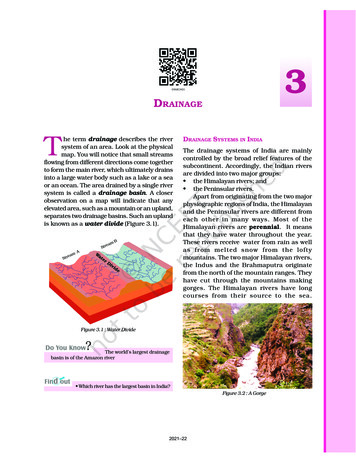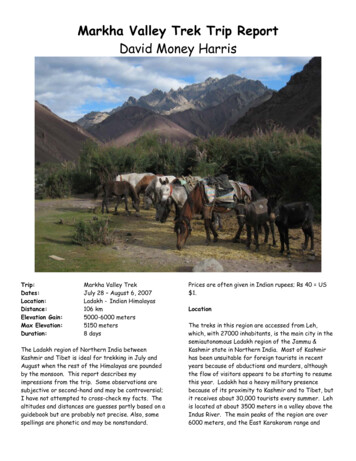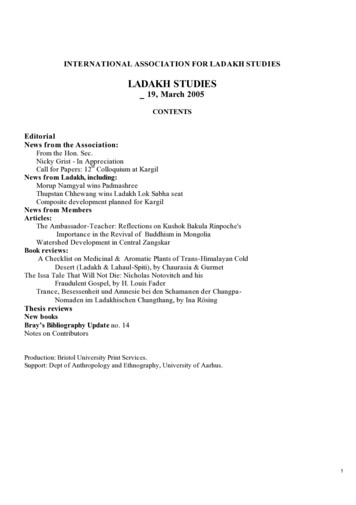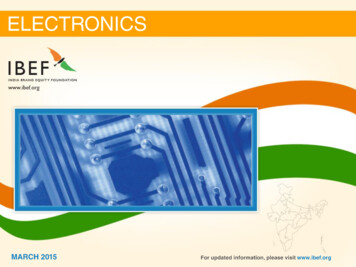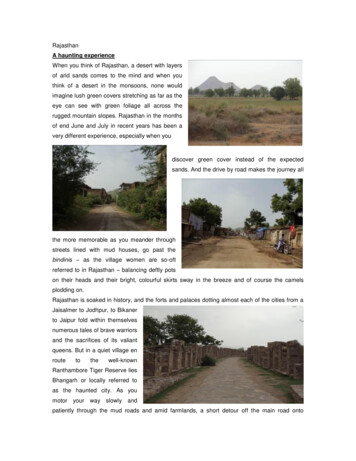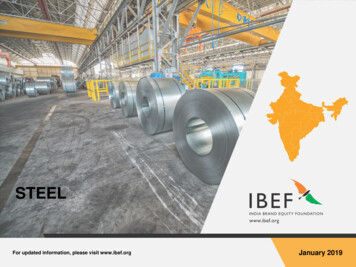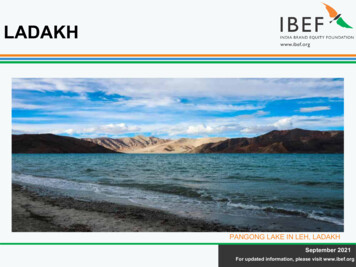
Transcription
LADAKHPANGONG LAKE IN LEH, LADAKHSeptember 2021For updated information, please visit www.ibef.org
Table of Contents2Executive Summary3Introduction4Physical Infrastructure9Social Infrastructure13Industrial Infrastructure16Key Sectors19Key Procedures & Policies22Appendix25
Executive summary12Robust tourism industry. Abundance of solar energy .3Ladakh is a global tourist destination, which attracts both domestic and foreign tourists. Its main attractions includePangong Tso lake and the world’s highest motorable road, Khardongla (18,350 ft.), along with some of the mostpopular monasteries, such as Hemis, Alchi, Lamayuru, Shey and Thiksay.In 2020, tourist arrivals in the Union Territory (UT) of Ladakh stood at 7,869.With 320 clear sunny days in a year and average daily global solar radiation as high as 2022 kWh/m2/annum,Ladakh is a favourable hotspot for solar power generation in India.In August 2020, the government of India announced 7.5 GW solar power park projects in Ladakh to becommissioned by 2022.Budding MSME sector In the state, 95% micro and small industries operate at a household-level, with handloom and metal-based worksholding the largest share.Ladakh annually manufactures 40-50 tonnes of Pashmina wool, which is one of the finest variant of wools.Handicraft serves as the secondary revenue generator, after agriculture and tourism in Ladakh.Growth in physical infrastructure 4 In February 2021, an MoU was signed between the Oil and Natural Gas Corporation (ONGC) and the UTadministration of Ladakh to develop a geothermal field development project with a power potential of 200 MWIn October 2020, the Defence Minister, Mr. Rajnath Singh inaugurated eight strategic bridges in Ladakh. He alsoannounced construction of 45 more bridges in Ladakh that will be completed by Border Roads Organisation (BRO) inthe next two years.A new Helipad Project was launched in 2020 to improve connectivity to the remote areas in Ladakh; the projectenvisages 36 new helipads across the districts of Leh and KargilSource: Central Statistics Office, Department for Promotion of Industry and Internal Trade ,1Including Puducherry, News articles3
INTRODUCTION4
Ladakh fact fileLeh5 persons per sq kmCapitalPopulation density59,146 sq.km.geographical area50.96%literacy rateadministrative districts:total population211,272141,988male populationfemale populationKey Insights353,2602672Sex ratio(females per 1,000 males) Hindi and English are Ladakh’s official languages; Ladakhi and Purgi are widely spoken languages in the UT. Important rivers flowing through Ladakh include the Indus, Zanskar and Shyok. Ladakh, formed on October 31, 2019, is the northernmost, largest and the second least populous UT of India. The UT sharesborders with Himachal Pradesh and Jammu & Kashmir, and its neighbouring countries are Pakistan, China and Afghanistan.Ladakh consists of two districts—Kargil and Leh. Ladakh’s climate is cold and dry and lies in the Greater Himalayan ranges, comprising salt and freshwater lakes, sand dunesand camels.Source: Census 20115
Advantage Ladakh Land of High PassesMSMEsSparsely inhabited Ladakh is naturally pollution-freeand provides a salubrious environment.The diverse topology with high-altitude cold desert inthe Great Himalayas and picturesque locations makethe UT a favoured destination among domestic andforeign tourists. Renewable Energy Ladakh has an abundance ofrenewable energy resourcessuch as solar and windLadakh has a potential togenerate 35 GW from solarenergy and 100 GW from windenergy.Source: Ministry of Statistics and Programme Implementation, News articles6 Ladakh has 95% MSMEs operating at a household-level,with handloom, handicraft and metal-based productsdominating the sector.The government has established 34 handicraft trainingcentres across the state to enhance skills of artisans andpreserve age-old heritage.Horticulture and Dairy Industry Ladakh’s agro-climatic conditions are best suitedfor horticulture and livestock rearing. Horticultureis the mainstay of the rural economy, providingemployment to thousands. The daily average demand of milk is 94,000 kg compared with the dailyaverage availability of milk 238,000 kg.This 50% surplus production of milk canbe used for exports and help generaterevenue for the local producers.
Ladakh in figuresSocial IndicatorsLiteracy rate (%)India: 77.7 Ladakh: 50.96Birth rate (per 1,000 population) (2018)India: 20.0 Ladakh: 20.4Industrial InfrastructurePPP projects under constructionIndia: 1,824 Ladakh: 7 Ladakh is divided into two districts, Leh and Kargil. Kargil had aliteracy rate of 61.25% as compared with 44.14% in Leh in 2011. As of July 2021, Ladakh had an installed power capacity of3,512.07* MW. Ladakh has only one airport, which operates limited commercialflights and is in Leh. Leh airport handled 297,466 passengers in 2021-22 (until July2021).Note: PPP: Public-Private Partnership, *- includes Jammu & Kashmir; **as of December 2020Source: Union Territory Administration Of Ladakh, Invest India7Physical Infrastructure in LadakhInstalled power capacity (MW) (July 2021)India: 386,888.15 Ladakh: 3,512.07*Wireless subscribers (million) (as of February 2021)India: 1,180.83 Ladakh: 11.91**National highway length (kms) (as of FY21)India: 136,440 Ladakh* : 2,423.21Airports (No.) (December 2020)India: 153 Ladakh: 1InvestmentsCumulative FDI equity inflow between October2019 and June 2021India: US 101.08 billion Ladakh : US 0.08 million
Ladakh Vision – 20502 INTEGRATED DEVELOPMENT Integrated CSCs across the UTDigital platforms for easy access for citizensDistrict CCCs for effective monitoringAccess to specialised healthcare within one hourMobile medical units for on demand healthcare ‘Zero Waste Ladakh’ Promotion of ‘Clean Energy’ Waste to energy1 SELFSUSTAINABLE4 SMARTINFRASTRUCTURE Sustainableagriculturedevelopment ThrustonSMEsandpromotion of investments Development & promotion oftourism Surplusemploymentopportunities Connectivitythroughallweather ready roads Green and sustainable publictransport systems 30 GW of power generation SMART integrated monitoringmechanisms Assured 24x7 quality watersupply ‘Tap Water Connectivity’ toevery household SMART education system Easyaccesstohighereducation facilities Skilldevelopmentandemployability21Note: CSCs: Commom Service Centres, CCCs: Community Care CentresSource: Union Territory Administration of Ladakh83 CARBON NEUTRAL34
PHYSICAL INFRASTRUCTURE9
Physical Infrastructure – AirportNumber of passengers ntil July 2021)Leh692,010821,689763,042321,462297,466Freight (Tonnes)AirportLehAircraft movement 945,9682,452 Kushok Bakula Rimpochee airport is in Leh and is the only domestic airport in Ladakh. The domestic airlines (from their destinations) flying to Lehinclude Air India (Delhi, Jammu, Chandigarh, Srinagar), GoAir (Delhi, Srinagar), SpiceJet (Delhi, Jammu) and Vistara (Delhi). According to Union Budget 2020-21, the government allocated Rs. 52 crore (US 7.04 million) for civil aviation. In September 2020, Airports Authority of India announced its plan to upgrade Leh airport by constructing a state-of-the-art new terminal buildingwith modern facilities at a cost of Rs. 480 crores (US 65.06 million). The airport will be able to handle two million passengers annually after thecompletion of construction work in December 2022. To provide an impetus to the tourism sector besides ensuring 24x7 connectivity to remote areas, Ladakh will get 36 new helipads by April 2021.Source: Airport Authority of India10
Physical infrastructure – initiatives and recent developments (1/4)1Roads 2Infrastructure Projects 3In July 2021, the Union Cabinet approved establishment of an Integrated Multipurpose Corporation in Ladakh to ensure socioeconomic development of the union territory.To provide grid connectivity to the far-flung villages of Ladakh, the central government approved intra-state transmission project at arevised estimated cost of Rs. 1,309.71 crore (US 179.51 million) in May 2021.In January 2020, a MoU was signed between NITI Aayog and UT administration of Ladakh to develop a strategic plan and providesupport to specific projects, especially in tourism, solar energy and others, which will be taken up under the public-privatepartnership mode.Railways Source: News articles11Currently, only two roads connect Ladakh from the rest of India, with limited access during winter season. 4,300 km road exist in Ladakh, with 39% under PWD and 61% under BRO.In August 2021, BRO constructed the highest motorable road in Eastern Ladakh at 19,300 ft. to boost the socio-economic conditionand promote tourism in the union territory.In June 2021, Mr. Rajnath Singh virtually inaugurated 11 bridges in Ladakh to boost border connectivity in the union territory.In June 2020, the transport ministry allocated Rs. 71 crore (US 9.61 million) to develop highways, by BRO, in Ladakh, Sikkim andTamil Nadu.In October 2020, the Defence Minister, Mr. Rajnath Singh inaugurated eight strategic bridges in Ladakh. He also announcedconstruction of 45 more bridges in Ladakh that will be completed by Border Roads Organisation (BRO) in the next two years.In March 2021, the central government announced to a parliamentary panel that a ‘standalone project’ to build a critical road inLadakh, along the border with China, is in progress.Bilaspur-Leh line is a new proposed high-elevation, all-weather broad-gauge railway track, which is aimed to connect Bilaspur inHimachal Pradesh to Leh in Ladakh.This railway line will hold a sociocultural significance, as it will boost tourist inflow and lead to a rise of economic activities in Ladakh.
Physical infrastructure – initiatives and recent developments (2/4)4Telecom 5National Optical Fibre Network (NOFN) in Ladakh is based on V-SAT; is installed at 172 sites, of which 165 sites comprise V-SAT.In July 2021, Airtel implemented additional spectrum deployment in Ladakh to boost network connectivity.In June 2020, the government announced plan to achieve 100% telecom connectivity in Ladakh. The project will be executed byBharat Sanchar Nigam Limited (BSNL) using the ‘Universal Service Obligation Fund (USOF)’.In February 2020, Bharti Airtel rolled out 4G and 2G networks in 26 villages across Ladakh. It became the first operator to bringmobile broadband to these villages in the high terranial region.In November 2020, Reliance Jio launched its mobile services in Zanskar area in Ladakh, extending its reach to the remotest andisolated part of Kargil.Renewable Energy With about 320 clear sunny days in a year and average daily global solar radiation as high as 2022 kWh/m2/annum, Ladakh is afavourable hotspot for solar power generation in IndiaLadakh has a potential to generate 35 GW from solar energy (32 GW in Leh (91%) and 3 GW in Kargil (9%)) and 4 GW from windenergy annually.In August 2021, Tata Power Solar secured a solar-plus battery storage project in Ladakh worth Rs. 386 crore (US 52.82 million)commercial operations of the project is expected by March 2023.In July 2021, the NTPC collaborated with the UT of Ladakh and Ladakh Autonomous Hill Development Council (LAHDC) to build agreen hydrogen mobility project in Ladakh and boost the renewable energy sector in the UT.In June 2021, CESL signed an MoU with the Union Territory of Ladakh to expand its decentralised solar portfolio in the UT.To make Leh self-sufficient in power, Ladakh, in collaboration with the Solar Energy Corporation of India (SECI), initiated a carbonneutral initiative for implementation of 50 MW solar storage plant in the UT.On August 15, 2020, PM Mr. Narendra Modi, during his Independence Day speech, announced the government’s aim to establish7.5 GW solar power park in Ladakh to help it become carbon neutral. This mega project is planned with an estimated outlay of Rs.45,000 crore (US 6.09 billion) and will commission in 2023. Solar Energy Corporation of India (SECI) will enter into the PowerPurchase Agreement (PPA) for a period of 35 years with successful bidders to purchase solar power.Note: kWh/m2: kilowatt-hour per square meter, GW: Giga Watt, V-SAT: Very Small Aperture TerminalSource: News Article, Union Territory Administration of Ladakh12
Physical infrastructure – initiatives and recent developments (3/4)6Helipad Project The new Helipad Project was launched in 2020 to improve connectivity to the remote areas in Ladakh.The project envisages 36 new helipads across the districts of Leh and Kargil.Helipads in the Leh district are being constructed at Demjok, Anlay, Kharnak, Korzok,Chumur, Tangtse, Chuchul, Shayok, Skympata,Dipling, Neryaks, Kanji, Markha, Panamik,Waris, Largyab, Agyam, Diskit and Sumor. Similarly, helipads in the Kargil district are beingconstructed at Kurbathang, Batalik, Sapi, Barsoo, Cheycheysna, Shephard Nala (Parkachik), Rangdum, Tangole, Padum, Longnak,Zangla, Tongri, Drass, Minamarag, Chiktan HQ, Namkila and Hinaskot.7Geothermal Energy Project In February 2021, an MoU was signed between the Oil and Natural Gas Corporation (ONGC) and the UT administration of Ladakh todevelop a geothermal field development project with a power potential of 200 MW.The project will be implemented in three phases: Phase-1: Development of 1 MW plant with ONGC Energy Centre as the implementing agency. Phase-2: Deeper and lateral exploration of geothermal reservoir by drilling optimal number of wells and setting up a highercapacity demo plant in Ladakh. Phase-3: Final commercial project as per capacity discovered during Phase-2Source: News articles13
Physical infrastructure – initiatives and recent developments (4/4)8Hydropower Projects In January 2021, the central government and the Central Water Commission (CWC) sanctioned eight hydropower projects (144MW) on the Indus river and its tributaries in Ladakh.As of 2020, there were several small projects, with a collective capacity of 113 MW on the Indus river, and the new projects willaugment the overall capacity for the power needs of the UT.These projects will be developed in the districts of Leh and Kargil in compliance with the Indus Waters Treaty with Pakistan. Leh: Durbuk Shyok (19 MW), Shankoo (18.5 MW), Nimu Chilling (24 MW), Rongdo (12 MW) and Ratan Nag (10.5 MW) Kargil: Mangdum Sangra (19 MW), Kargil Hunderman (25 MW) and Tamasha (12 MW)9Zanskar Winter Sports Festival Source: News articles14In January 2021, Union Sports and Youth Affairs Minister, Mr. Kiren Rijiju, inaugurated the first-ever Khelo India Zanskar WinterSports Festival in Padum, ZanskarThe sports festival spanned 13 days and was organised by the Ladakh UT administration to promote Zanskar as a touristdestination for winter sports.The Union Sports Ministry plans to provide sports facilities in all regions of Ladakh and promote the UT as a centre for ice hockey.
SOCIAL INFRASTRUCTURE15
Social infrastructure – EducationPremier institutions in LadakhLiteracy rates (Census 2011)National Research Institute forSowa-Rigpa, LehGovernment Degree College,ZanskarNational Institute of Electronics &Information Technology, LehGovernment Degree College,NubraCentral Institute of BuddhistStudies, LehGovernment Degree College,KhaltsiEliezer Joldan Memorial DegreeCollege, LehGovernment Degree College,DrassGovernment Degree College,KargilLiteracy rate(%)50.96Male literacy(%)56.39Female literacy(%)42.87 As per the Budget 2020-21, the government allocated Rs. 38,751 crore (US 5.25 billion) under the ‘Samagra Shiksha’ scheme. This is anincrease of 6.8% from the revised estimates of 2019-20. In November 2020, Ladakh administration increased its education budget to Rs. 871 crore (US 118.02 million) in the current fiscal year toenhance the education sector in Ladakh. According to India’s Census 2011, Ladakh had a literacy rate of 50.96%, the male literacy rate is 56.39% and female literacy rate is 42.87%. In November 2019, the Union Cabinet approved the establishment of the National Institute for Sowa-Rigpa in Leh as an autonomous organisationunder the Ministry of AYUSH. In February 2019, PM Mr. Narendra Modi launched University of Ladakh, the first-ever varsity in the Ladakh UT. The University of Ladakhcomprises degree colleges of Leh, Kargil, Nubra, Zanskar, Drass and Khaltsi under its cluster. In April 2021, a centre of excellence and wellness was established by the Indian Army in collaboration with Hindustan Petroleum CorporationLimited (HPCL) to guide the youth of Ladakh for one year in preparing them for various medical and engineering examinations. In August 2021, the Indian government passed a bill to establish central university in Ladakh to enhance education accessibility in the unionterritory.Source: University of Ladakh, Union Budget 2020-21, Census 2011, News Article16
Social infrastructure – HealthHealth SchemeHealth Infrastructure as of FY20ObjectiveDistrict Hospitals2ICDSFocusses on nutritional status of children (6 months to6 year) and pregnant & lactating women enrolled inanganwadi centres across the UT.Sub-District Hospital3Sabla and KSYProvide supplementary nutrition to adolescent girls inthe age group of 11-18 years.Primary Health Centres57MBP (PMMVY)Family Welfare Centres270Provide financial assistance to pregnant and lactatingwomen ensuring their delivery conditions and conductregular check-up of mother and the child.Ladli BetiImprove the skewed child-sex ratio.Bed Strength811PM-JAYProvide a health cover of Rs. 5 lakhs (US 6,819.15)per family per year for secondary and tertiary carehospitalization As of March 2020, Ladakh had two District Hospitals, three Sub-District Hospitals, 57 Primary Health Centres, 270 Family Welfare Centresand 811 Bed Strength. As of July 30, 2020, 70% people in Leh and Kargil were issued ‘Golden’ cards of Ayushman Bharat. On March 2020, Union Territory Administration of Ladakh signed a Memorandum of Understanding (MoU) with Bajaj Allianz GeneralInsurance Company Ltd. to implement Ayushman Bharat-Pradhan Mantri Jan Arogya Yojana (AB-PMJAY) for the contract period of one year.Note: ICDS – (Integrated Child Development Services), KSY - Kishore Shakti Yojana, MBP - Maternity Benefit Program, PMMVY - Pradhan Mantri Matri Vandana Yojana,PM-JAY - Pradhan Mantri Jan Arogya YojanaSource: Directorate Of Health Services - Kashmir, Ministry of Health and Family Welfare, Union Territory Administration of Ladakh, News Article17
INDUSTRIAL INFRASTRUCTURE18
Industrial infrastructure – Industrial estatesIndustrial Estate Nubra:10 HaIndustrial EstateKhaltsi: 01 Ha(15 Plots)Industrial EstatePheyang: 15 Ha (184Plots)Industrial Estate Leh:12 Ha (121 Plots)Industrial EstateChanchik: 1.6 Ha (54Plots)Durbuk & TangsteIndustrial EstateKargil:0.5 Ha (10 Plots)NyomaExisting Industrial EstateNote: Ha: HectorSource: Union Territory Administration of Ladakh19Pashmina Production Centres - Changthang Region
Industrial infrastructure – Micro and small-scale industryShare of Micro And SmallScale Industry in Ladakh (2019) In Ladakh, 95% micro and small industries operate at a householdlevel. Ladakh manufactures 40-50 tonne of Pashmina wool annually; thisis 1% of the global production. Handicraft serves as the secondary revenue generator, afteragriculture and tourism in Ladakh. There are 34 handicraft training centres in Ladakh that have trained 3,000 trainees since the last five years. Out of 34 handicraft trainingcentres, 23 centres are in Leh district and 11 in Kargil district. In October 2020, the Union Cabinet, chaired by the Prime Minister,Mr. Narendra Modi approved a special package of Rs. 520 crore(US 70.48 million) for Jammu & Kashmir and Ladakh under theDeendayal Antyodaya Yojana-National Rural Livelihood Mission forfive years until 2023-24. In June 2021, the Tribal Cooperative Marketing DevelopmentFederation of India (TRIFED) announced to implement Van DhanVikas Kendra (VDVK) in the Union Territory of Ladakh andoperationalise the formerly sanctioned 10 VDVK clusters.Source: Union Territory Administration of Ladakh, News Sources20Handloom12%Metal based19%42%Handicrafts andWood Work13%14%Repairing & ServicingOthers
KEY SECTORS21
Key sectors – Agriculture, Horticulture and Milk & dairyAgriculture Agriculture is the backbone of Ladakh’s economy, as it engrosses 70% of the working force, mostly ascultivators, agricultural labourers and livestock rearers. In 2019, Ladakh had 33% of the total land as cultivated, under agricultural activities, with production of 100,000quintal per annum of food grains. The key crops grown are wheat, barley and rice. In February 2020, the ‘Mission Organic Development Initiative’ launched by the Indian Government worth Rs. 500crore (67.80 million) envisioned Ladakh to turn in to 100% organic farming by 2025. In July 2021, the Agricultural and Processed Food Products Export Development Authority (APEDA) partneredwith agricultural stakeholders in Ladakh to boost agricultural produce and improve farmers’ income in the region. Horticulture plays a key role in supplementing the income of farmers in Ladakh.Horticulture In 2019, Ladakh produced 160,000 quintal of fruits. Of this, 70% of the total production of apricot and apple wasfrom Khaltsi block, Leh district. Other fruits such as almond, grapes, peach, pear and walnut are grown in the warmer lower belts of Ladakh. In September 2021, the first consignment of apricot was exported to Dubai from Ladakh, boosting agriculturalproduct exports from the union territory.Milk & Dairy In 2019, Ladakh produced 238,000 kg per day of milk, i.e., 600 grams/capita/day, almost double of nationalaverage (394 grams/capita/day). In 2019, Union Territory Administration of Ladakh estimated that the milk and dairy industry is worth Rs. 250 crore(US 33.90 million); however, it has not been developed in an organised manner to utilise its full potential. The daily average demand of milk is 94,000 kg compared with the daily average availability of milk 238,000 kg.This 50% surplus production of milk can be used for exports and help generate revenue for the local producers. In October 2020, National Dairy Development Board (NDDB) and UT Administration of Ladakh signed an MoU toconduct a benchmark survey with a view to promote dairying and rural livelihoods in Ladakh.Note: Quintal 100 Kilogram,Source: Union Territory Administration of Ladakh, Economic Review 2014-15, News Article22
Key sectors – Tourism Since its opening for tourists in 1974, Ladakh is renowned for itsremote mountain beauty and distinct culture. The tourism sector inthe UT has secured a comprehensive recognition as a significantindustry due to its potential to create employment opportunities andgenerate income on a large scale. The key tourist attractions include Zanskar Valley, Nubra Valley,Pangong Tso Lake, Spituk Gompa, Hemis National Park, MagneticHill, Shanti Stupa, Hemis Monastery and Khardung La Pass.Total Tourist Arrivals in Ladakh (2019P)38,652Total279,937 Total tourist arrivals to the UT reached 279,937 in 2019, out of which241,285 were domestic tourists and 38,652 were foreign tourists.Foreign241,285 In 2020, total tourist arrivals in Ladakh stood at 7,869, of which 6,743were domestic and 1,126 were foreign tourists. According to Union Budget 2020-21, the government allocated Rs.47.50 crore (US 6.2 million) for the tourism sector. On April 20, 2020, Ministry of Tourism conducted its 5th webinar onthe rich heritage of Ladakh titled ‘Ladakh: Explore the Unexplored’,under ‘DekhoApnaDesh’ webinar series. In November 2020, Ladakh rolled out its first tourism incentive policywith focus on ensuring equitable and sustainable development of allregions in the union territory.DomesticTotal Tourist Arrivals in Ladakh (2020)1,126Total7,869DomesticForeign6,743Note: P – Provisional. *-until June 2020Source: Ministry of Tourism, Union Territory Administration of Ladakh, News Article23
KEY PROCEDURES AND POLICIES24
Contact listAgencyDirectorate Of Industries and Commerce-25Office of the Secretary, Industries andCommerceContact informationDirector Industries and Commerce Office, NearCourt Complex, Leh, Ladakh.Phone: 91-01982-259233E-mail: ndustries.ladakh.gov.in/index.html2nd Floor, Secretariat UT Ladakh, NearCouncil Complex, Leh, LadakhPhone: 91-01982-255567Fax: 91-01982-255568E-mail: dakh.gov.in/index.html
UT acts and policies1The Jammu And Kashmir Reorganisation Act, 2019Provision to reconstitute the State of Jammu and Kashmir into two union territories calledJammu and Kashmir, and Ladakh on October 31, 2019.2National Tourism Policy, 2002Develop tourism in India in a systematic manner.Position tourism as a key engine of economic growth and harness its direct and multipliereffects for employment and poverty eradication in an environmentally sustainable manner.3Labour Laws and New Labour CodesIn July 2021, the Chief Labour Commissioner (CLC) reviewed implementation of labour lawsand new labour codes.426Jal Jeevan MissionUnder the Jal Jeevan Mission (JJM), Ladakh plans to provide 32,514 tap water connectionsto UT households by FY22 and 11,568 tap water connections to households by next year andachieve the JJM target by 2022.
APPENDIX27
SourcesDataSourcesInstalled power capacity (MW)Central Electricity AuthorityWireless subscribers (No.)Telecom Regulatory Authority of IndiaInternet subscribers (million)Telecom Regulatory Authority of IndiaNational highway length (km)NHAI & Roads and Building DepartmentAirports (No.)Airports Authority of IndiaLiteracy rate (%)Census 2011Cumulative FDI equity inflows (US billion)Department for Promotion of Industry and Internal TradeOperational PPP projects (No.)DEA, Ministry of Finance, Government of India28
Exchange ratesExchange Rates (Fiscal Year)Exchange Rates (Calendar Year)YearRs. Equivalent of one US YearRs. Equivalent of one US 21*74.25Note: As of August 2021Source: Reserve Bank of India, Average for the year29
DisclaimerIndia Brand Equity Foundation (IBEF) engaged Sutherland Global Services Private Limited to prepare/update this presentation.All rights reserved. All copyright in this presentation and related works is solely and exclusively owned by IBEF, delivered during the course ofengagement under the Professional Service Agreement signed by the Parties. The same may not be reproduced, wholly or in part in any materialform (including photocopying or storing it in any medium by electronic means and whether or not transiently or incidentally to some other use of thispresentation), modified or in any manner communicated to any third party except with the written approval of IBEF.This presentation is for information purposes only. While due care has been taken during the compilation of this presentation to ensure that theinformation is accurate to the best of Sutherland Global Services’ Private Limited and IBEF’s knowledge and belief, the content is not to be construedin any manner whatsoever as a substitute for professional advice.Sutherland Global Services Private Limited and IBEF neither recommend nor endorse any specific products or services that may have beenmentioned in this presentation and nor do they assume any liability, damages or responsibility for the outcome of decisions taken as a result of anyreliance placed on this presentation.Neither Sutherland Global Services Private Limited nor IBEF shall be liable for any special, direct, indirect or consequential damages that may arisedue to any act or omission on the part of the user due to any reliance placed or guidance taken from any portion of this presentation.30
In July 2021, Airtel implemented additional spectrum deployment in Ladakh to boost network connectivity. In June 2020, the government announced plan to achieve 100% telecom connectivity in Ladakh. The project will be executed by Bharat Sanchar Nigam Limited (BSNL) using the 'Universal Service Obligation Fund (USOF)'.
